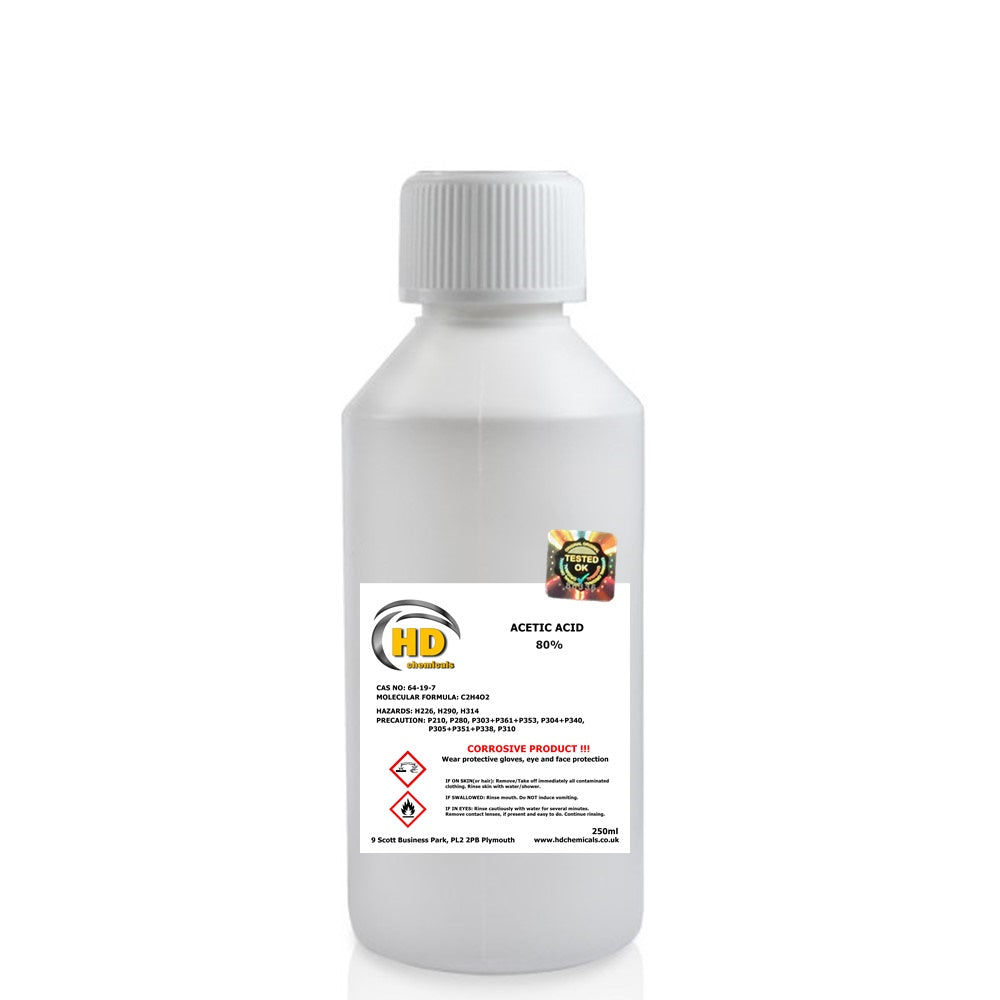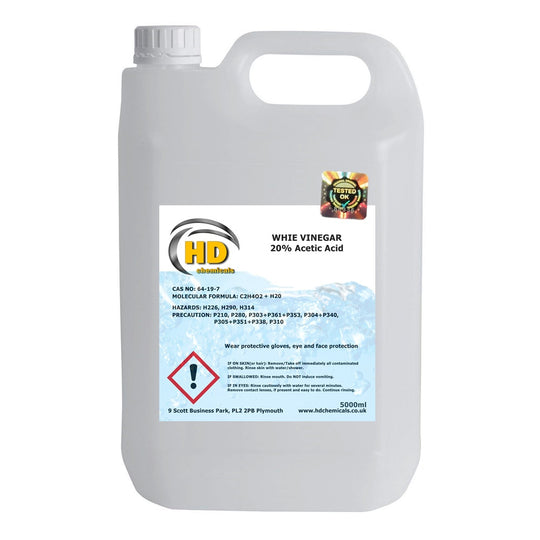Acetic acid, commonly known as vinegar when diluted, is a versatile and powerful substance with various applications. However, when it comes to using 80% acetic acid, safety and proper dilution techniques are paramount. In this comprehensive guide, we'll explore the world of 80% acetic acid, from understanding its properties to dilution techniques and practical applications.
Understanding 80% Acetic Acid
80% acetic acid, also known as glacial acetic acid, is a highly concentrated form of acetic acid. Unlike the familiar household vinegar, which typically contains 4-8% acetic acid, this concentrated form can be a potent and potentially hazardous chemical if mishandled.
Properties of 80% Acetic Acid:
- Concentration: At 80% concentration, acetic acid is significantly stronger and more corrosive than household vinegar.
- Color and Odor: It is colorless and has a pungent, vinegar-like odor.
- Corrosiveness: Due to its high acidity, it can corrode certain materials and should be handled with care.
Safety First - Handling and Storage
Before we delve into the various applications and dilution techniques, it's crucial to understand and implement safety measures when working with 80% acetic acid.
Safety Precautions:
- Protective Gear: Always wear appropriate protective gear, including gloves, safety goggles, and a lab coat or apron to shield your skin and eyes.
- Ventilation: Use 80% acetic acid in a well-ventilated area or under a fume hood to avoid inhaling potentially harmful fumes.
- Avoid Mixing: Never mix acetic acid with bleach or chlorine-containing products, as this can produce toxic chlorine gas.
- First Aid: Familiarize yourself with the proper first-aid measures in case of exposure or accidents.
- Storage: Store 80% acetic acid in a well-sealed container, away from direct sunlight and extreme temperatures, and in a designated chemical storage area.
Dilution Techniques
Why Dilute 80% Acetic Acid
Dilution is essential for several reasons:
- Safety: As mentioned earlier, concentrated acetic acid can be hazardous. Dilution reduces its potency, making it safer to work with.
- Cost-Effective: Dilution extends the use of 80% acetic acid, saving you money in the long run.
- Tailored Concentration: Different applications require different concentrations, and dilution allows you to customize the solution to your needs.
Calculating Dilution Ratios
Dilution ratios are typically expressed as a ratio of the volume of the concentrated acid to the volume of the diluent (usually water). The formula for calculating the dilution ratio is:
Dilution Ratio = Volume of Concentrated Acid / Volume of Diluent
For example, to create a 10% acetic acid solution, you would use the formula to determine the amount of concentrated acid and diluent needed.
Common Dilution Ratios
Let's explore some common dilution ratios for practical applications:
1. Cleaning Solution (10% Acetic Acid):
- To make a 10% acetic acid cleaning solution, mix 1 part of 80% acetic acid with 9 parts water. This is suitable for general household cleaning tasks.
2. Descaling Solution:
- For descaling appliances, create a 25% to 50% acetic acid solution, depending on the severity of scale build up. Mix 1 part 80% acetic acid with 3 to 1 part water.
3. Pickling Solution:
- In food preservation, you might use a 5-7% acetic acid solution for pickling vegetables. Mix 1 part 80% acetic acid with 14 to 19 parts water, add spices and salt for flavor.
Practical Applications
Now that we understand the importance of dilution, let's explore some practical applications of acetic acid solutions:
Cleaning with Diluted Acetic Acid
Diluted acetic acid is an effective and eco-friendly cleaning agent. Here's how to create a simple cleaning solution:
Ingredients:
- 80% Acetic Acid
- Water
Instructions:
- In a mixing container, measure the desired amount of 80% acetic acid.
- Add the appropriate amount of water according to the chosen dilution ratio.
- Mix thoroughly.
Application:
- Use the solution to clean various surfaces, including countertops, glass, and bathroom fixtures.
- Allow the solution to sit for a few minutes before wiping it off to effectively dissolve dirt and grime.
Descaling Appliances
Appliances like kettles, coffee makers, and dishwashers can develop scale build up over time. Descaling with diluted acetic acid can help restore their efficiency:
Instructions:
- Prepare a descaling solution with the appropriate dilution ratio.
- Fill the appliance's reservoir with the solution.
- Run a descaling cycle as per the manufacturer's instructions.
Tips:
- For stubborn scale buildup, you may need to repeat the process or increase the concentration slightly.
Pickling and Food Preservation
Acetic acid is a key ingredient in pickling and food preservation. Here's a simple recipe for pickling vegetables:
Ingredients:
- Fresh vegetables (e.g., cucumbers, carrots, peppers)
- 80% Acetic Acid
- Water
- Salt
- Spices (e.g., dill, garlic, peppercorns)
Instructions:
- Wash and prepare the vegetables.
- Create a pickling brine by mixing the desired amount of 80% acetic acid with water, salt, and spices.
- Submerge the vegetables in the brine in sterilized jars.
- Seal the jars and store them in a cool, dark place.
Horticulture and Weed Control
Diluted acetic acid can serve as an eco-friendly weed control solution for your garden or driveway. Here's how to use it:
Ingredients:
- 80% Acetic Acid
- Water
Instructions:
- Mix the acetic acid with water to create a weed-killing solution with a concentration of around 10-20%.
- Carefully apply the solution to the weeds, ensuring it doesn't come into contact with desirable plants.
- Allow time for the solution to penetrate and kill the weeds.
Caution:
- Be cautious when using this method, as acetic acid can harm desirable plants as well if not applied carefully.
Advanced Applications
Industrial and Laboratory Uses
While our focus has been on household applications, it's worth mentioning that industries and laboratories utilize highly concentrated acetic acid for specific purposes. These applications require expert handling and are typically beyond the scope of household use.
Health and Safety Considerations
It's essential to be aware of potential health hazards associated with acetic acid exposure. While it has numerous practical applications, safety should always be a top priority. If you're unsure about using acetic acid for a particular task, seek professional advice or guidance.
In conclusion, 80% acetic acid is a potent and versatile chemical that, when properly diluted, can be used for various practical applications, from cleaning and descaling to pickling and weed control. By understanding its properties, following safety measures, and calculating appropriate dilution ratios, you can harness the power of acetic acid safely and effectively. Remember that safety always comes first, and if you have any doubts, consult with experts in the field.


